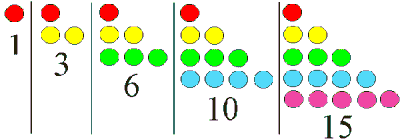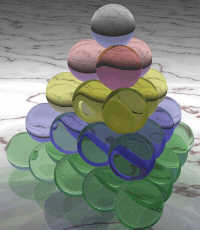Hello, and welcome to the 3rd episode in this 5 part series! In this blog we will be formally writing the Hockey-stick Principle showcased in the last blog, see what it has to do with multi-dimensional triangles, and finish our study on this pattern of Pascal’s triangle.
Formal writing of the Hockey-stick Principle
To begin, we will write this principle formally, like so:
For all non-negative n and m, where m<=n, we have that:
mPm+m+1Pm+m+2Pm+…+nPm=n+1Pm+1
and
mP0+m+1P1+m+2P2+…+nPn-m=n+1Pn-m
Proof:
We will do this by induction on n (Letting m be arbitrary)
Base case: n=0
In this case, we have m=0 (Since m is non-negative m>=0 and m<=n<=0), so we have:
0P0=1=1P1
and
0P0=1=1P1 (both equations are the same in this case)
Induction step: n=k => n=k+1
In this case, we know that:
mPm+m+1Pm+m+2Pm+…+kPm=k+1Pm+1
By the property of Pascal’s triangle, and using substitution, we get:
mPm+m+1Pm+m+2Pm+…+k+1Pm=k+1Pm+1+k+1Pm=k+2Pm+1
And for the second equation, we have:
mP0+m+1P1+m+2P2+…+kPk-m=k+1Pk-m
And once again, using substitution and what I will from now on call ‘Pascal’s identity,’ we get:
mP0+m+1P1+m+2P2+…+k+1Pk+1-m=k+1Pk-m+k+1Pk+1-m=k+2Pk+1-m
Multi-dimensional Triangles?
Remember the patterns we found last time, with the first 3 diagonals? This property extends these patterns. For example, look what happens when you expand the recursive definition of triangular number (Which we found were the same as 2nd diagonal numbers)
Tn=n+Tn-1=n+(n-1)+Tn-2=…=n+(n-1)+(n-2)+…+3+2+1=
This is saying the exact same thing as the hockey-stick principle for m=2:
2P2+3P2+4P2+…+nP2=n+1P3
Ok, well not exactly. But look what happens when we flip the equation and substitute for some of the values:
n+1P3=1+2+3+3+…+n
And for m=1 we get something similar
1P1+2P1+3P1+…+nP1=n+1P2
or
n+1P2=1+1+1…+1+1
With n+1 1’s.
And now we introduce the multi-dimensional triangle numbers! To start, let’s look at the 0th, 1st, and 2nd dimensional versions, so we can reason our way to their 3rd, 4th, 5th, and more counterparts. To start, the 0th dimensional, or dot number(s):
0th dimensional triangle numbers (Dot numbers)
These numbers are very boring. They consist of counting the number of ‘dots’ in a 0th dimensional triangle. However, a 0th dimensional triangle is always a dot, so all these numbers are 1.
1st dimensional triangle numbers (Line numbers)
These numbers are a bit more interesting, but still boring. Just as before, they consist of counting the numbers of dots in a 1st dimensional triangle, which is a line. The key thing to recognize is that the nth 1D triangle number is made up of the nth, n-1st, n-2nd, n-3rd, … 1st 0D triangle numbers, (Since they are all dots). This may be trivial for this case but it becomes much more interesting as we go along.
2nd dimensional triangle numbers (Normal triangle numbers)
These are the first interesting numbers. As we showed in the first part, these numbers are formed by counting the number of dots in triangles. The key takeaway now is that these triangles are formed all from the previous ‘line numbers,’ as you can see below

So, just like before, the nth 2D triangle number is made up of the nth, n-1st, n-2nd, n-3rd, … 1st 1D triangle numbers. This pattern can be seen in all dimensions, which we will see in the next dimension.
3rd dimensional triangle numbers (Tetrahedral numbers)
The tetrahedral numbers, just like the last 2 dimensions, are the sum or the previous dimension’s triangle numbers, as you can see below:

Each layer of the tetrahedron represents a triangular number!
Going beyond
You can easily imagine a 4D triangle number by continuing this pattern. For example, the 5th 4D triangle number would be the sum of the first 5 tetrahedral numbers, which evaluate to the following (Where Ten is the nth tetrahedral number)
You can easily imagine a 4D triangle number by continuing this pattern. For example, the 5th 4D triangle number would be the sum of the first 5 tetrahedral numbers, which evaluate to the following (Where Ten is the nth tetrahedral number)
Te1=1
Te2=1+3=4
Te3=1+3+6=10
Te4=1+3+6+10=20
Te5=1+3+6+10+15=45
So the 5th 4D triangle number is 1+4+10+20+45=80!
Conclusion
Now that we have wrapped up this pattern of Pascal’s triangle, we can move on to the other 2 patterns I have planned! In part 4 we will look into probability and combinatorics, and in part 5 we will finish off with binomials! See you all next time, and have a great week!
One Reply to “Pascal’s Triangle (Part 3):”